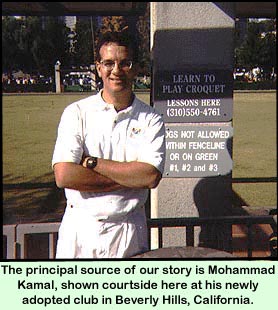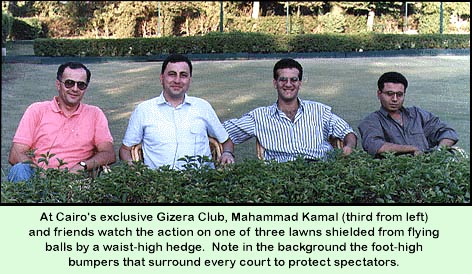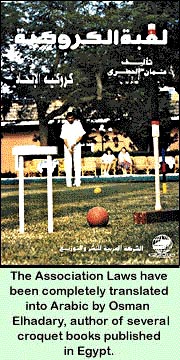

|
Back to |
| The Front Page |
| News & Features |

WITH A LONG TRADITION
AND A STRONG NATIONAL ORGANIZATION
EGYPT JOINS THE CROQUET WORLD
AS A MAJOR PLAYER
by Bob Alman
photos and source materials courtesy of Mohammad Kamal
With half a hundred lawns, 5,000 dues-paying members of the Egyptian Croquet Association in 30 clubs, and 70 years to develop their own style of croquet,
 the Egyptians joined the WCF in 1995 and burst upon the world scene with a
flourish in their international debut in Italy last September, winning all
the top places in the first Golf Croquet World Championship. Egypt will
host the second one in October of 1997 and has made a strong bid to host as
well the WCF World Championship (Association Laws) in 1998. Mohammad Kamal,
an Egyptian medical doctor now living and doing research in Southern
California and playing croquet with the Beverly Hills Croquet Club, has
helped flesh out the story of a flourishing national croquet culture unlike
any other, in the midst of the Arab world.
the Egyptians joined the WCF in 1995 and burst upon the world scene with a
flourish in their international debut in Italy last September, winning all
the top places in the first Golf Croquet World Championship. Egypt will
host the second one in October of 1997 and has made a strong bid to host as
well the WCF World Championship (Association Laws) in 1998. Mohammad Kamal,
an Egyptian medical doctor now living and doing research in Southern
California and playing croquet with the Beverly Hills Croquet Club, has
helped flesh out the story of a flourishing national croquet culture unlike
any other, in the midst of the Arab world.
At first glance, most of the croquet lawns of Cairo or Alexandria look comfortingly familiar to a visitor from the U.S. or the British Commonwealth. They vary in quality, as do lawns everywhere, but most are perfectly fine, planted with hardy, heat-resistant Bermuda-like creeping grasses cut short, laid out with six wickets and stake and with boundaries of the standard full-sized dimensions. Mallets, balls, and hoops are all up to world standards in every respect.

All the courts are lighted (27 in Cairo alone) and in the "off season" of roughly May through October, when the heat is most oppressive, tournaments typically run from twilight to midnight. Once the games begin, you see the most vivid distinction of croquet in Egypt. Their traditional game is Egyptian Golf Croquet, and it quickly becomes evident that this game brings croquet as close as it could ever be to the status of a spectator sport. As an inter-club tournament begins, the foreign visitor is amazed by the noisy enthusiasm of the spectators - dozens or even hundreds of them - applauding, whistling, even shouting approval to individual players after good shots. But as the next player lines up for his shot, a respectful silence prevails, all through the backswing until contact is made, and then the crowd has another moment to register its approval or dismay. Only in Egypt is this colorful, rhythmic collaboration of spectators and players to be witnessed around a croquet lawn. The spectators have another good reason to be attentive: they could be struck and perhaps seriously injured by a croquet ball! Why do the Egyptians hit the ball so hard? The invariable answer is, "It works." For players schooled in only one game - Egyptian Golf Croquet - the way to hit the ball is hard; VERY hard; so hard, according to WCF Secretary General Chris Hudson, that the Egyptians have evolved a subtle variation in grip to allow for an amplified hinging action of the wrist, imparting added velocity at the end of the swing. When Mohammad Kamal, an Egyptian resident of Southern California, demonstrated his "typically Egyptian" swing, I was curious about his pronounced "pidgeon-toed" stance in addressing the ball. He lifted his trousers to reveal scars on the inside of both ankles. "You hit your ankle after a big backswing, and it is very, very painful," he explained. SPECTATORS ARE NOISY, ATTENTIVE....AND WELL PROTECTED
To protect spectators from fast-flying balls, courts typically have green-painted wooden bumpers extending a foot or more above the surface, as well as waist-high hedges. But even that isn't always enough to protect the crowd, should a very fast ball hit an irrigation head or other bump or fly into the air after impact with another ball. According to Kamal, "Sometimes the game will stop to allow the spectators to move out of the line completely so a player can make the shot he needs to make without worrying about injuring someone." Egyptian Golf Croquet is a 13-point game which resembles the variety of Golf Croquet described in the Association Laws. A few variations, however, inpart added tactical nuance and call for more refinement in shooting skills. Only on a roquet, for example, may the striker's ball advance near the pioneer hoop and take the next turn from that position after the current hoop is made; this rule encourages players to develop cut-rush skill that would be the envy any pool-hall shark. If a ball advances on its own (without striking another ball) into the quadrant of the next hoop and the current one is scored in the same rotation, the "pioneer" ball must be moved back to one of several designated "penalty" positions marked on the court before taking its next turn. The ideal spectator sport is interactive, fast, exciting, and easy to understand and track. Egyptian Golf Croquet fills the bill. But ALL forms of Golf Croquet share most of these characteristics, so why aren't there large crowds of cheering spectators at Golf Croquet events in America, in England, in Australia, if such a thing goes on in Egypt? CROQUET GAINED A FOOTHOLD AT MULTI-SPORTS CLUBS
To answer this question, one must take more than a few steps back, for a broader perspective. Every one of the croquet clubs in Egypt is only a part of a broader spectrum of activity at a sports club or "country club." These private institutions, often with the financial support of the government, are accessible to a broad range of Egyptians, from the middle to the upper class. Some have only modest fees - including a club originally built by a manufacturer for its worker and their families; others - such as the renowned Gizera Club in Cairo - are very expensive and exclusive. Thus, many thousands of Egyptians already "belong" to a club that includes croquet in a mix of other sports and social events. It is hardly surprising, then, that the Egyptian Croquet Association has a thriving membership roster of about 5,000, paying individual dues amounting to about $5.00 U.S. dollars annually - and those are just the players who compete in sanctioned tournaments; other thousands in Egypt's sports and "country clubs" have every opportunity to try out croquet and see if it suits them. These casual players often crowd the sidelines to cheer their more competitive player friends to victory in interclub tournaments. When family members and friends who don't play croquet at all drop by to watch the action, they can understand immediately what is happening, so the game holds their interest. Everyone can appreciate a long hit, or a spectacular 30-foot wicket shot made from a 45-degree angle. Kamal's croquet initiation is representative: "One day when I was twelve or thirteen, I passed the croquet courts at Gizera with a friend, and it looked interesting and we decided to try it out. We liked it, and we kept playing it." But Kamal could not compete in a tournament until he reached the age of 21, by law of the Egyptian Croquet Association. He could play all he liked; he just couldn't compete in a tournament. The rule has never been seriously questioned. As a consequence, the typical age of a new croquet champion in Egypt is 21. INTERCLUB TEAMS ARE COMPOSED EQUALLY OF MEN AND WOMEN
Affinity to one's club helps to fuel the spirited rivalry that characterizes Egyptian croquet. The Egyptian Croquet Association organizes interclub play in two tightly scheduled "leagues," culminating in national championships at the end of the winter "high season." The championship events include "mixed doubles" as well as women's singles, open singles and doubles and club teams. The teams must be composed of an equal number of men and women players The proportion of women to men at the top ranks of open competition is pretty much the same as in other countries. Very rarely does a women achieve the top level of competition. Only one woman has ever reached the finals of the singles national championship.

How did croquet come to Egypt, only to be cut off from the mainstream and develop in its own way, as did the United States, with its own national version of the game? As with croquet in the United States, it all started with England. The proprietary interest of Great Britain in the Suez Canal mandated a strong consular presence in Egypt, which after World War I became a British protectorate. A casual variety of "lawn croquet" was popular in the diplomatic community in the early part of the century, and by the 1920's, the first regulation courts were being built at some of the best clubs in Egypt. By the 40's, there were dozens of courts, but still no organized national association. After the British left Egypt in the early 50's, croquet started to develop a uniquely Egyptian character, in tandem with the nationalist politics of the era. Ahmad Hamroosh, a former army officer and renowned journalist, was a pivotal figure in the development of the Egyptian game, and in 1967 he formally organized the Egyptian Croquet Association. HEROS, PATRIARCHS, AND CROQUET CELEBRITIES STAND TALL
In addition to Hamroosh, Egypt's croquet patriarch, other figures loom large in Egyptian croquet. Osman Elhadary has written several books on croquet in Arabic, the latest of which is is translation of the Association Laws A revered croquet hero who died young is 1972 is Mahmoud Abdelaziz. Known to be suffering from terminal cancer and in constant pain, he nevertheless won the national championship that year, succumbing very shortly thereafter. Ramadan Gabr is famed for his strategic genius. In the 60's and 70's, he virtually reinvented Egyptian Golf Croquet, and his strategies are still the standard for top-level play. Khaled Younis is widely regarded today as Egypt's top player. He is one of few players to have won the national singles, doubles, and mixed doubles championships. He defeated a fellow Egyptian to win the first Golf Croquet World Championship in Italy in September. With a degree in physical education, he has recently been granted permission to write his Master's thesis on croquet - no doubt another first for Egyptian croquet. Reportedly, he has decided not to take up International Rules croquet, fearing it might damage his winning ability in his native game. HOW POPULAR WILL 'ASSOCIATION CROQUET" BECOME IN EGYPT?
 Mohammad Kamal does not expect International Rules croquet to take off
immediately in a big way in Egypt. The established national game is too
solidly entrenched and too well loved to be abandoned. As in America, the
native variety of croquet will remain dominant. International Rules will be
the medium of international competition, but not the staple of club play in
Egypt in the foreseeable future.
What can the rest of the croquet world learn from Egypt's example? Part of
this question is being addressed by the WCF's International Laws Working
Party, who have been given English translations of the rules of Egyptian Golf
Croquet to determine which version should be used in next year's Golf
Croquet championship in Cairo and which rules - or combination of rules -
should be used in international Golf Croquet competitions thereafter.
WCF Secretary General Chris Hudson is understandably impressed with the
achievement of Egypt's national association, and he is equally enthusiastic
about the potential of the Egyptian players on the world stage: "Every time
they play, they automatically practice running hoops from long range and
hitting in from long distances, and as a result the top Egyptian players have
become extremely proficient at these two shots."
But though he is open-minded on the subject, Hudson has yet to be convinced
of the superiority of the Eyptians' unique form of Golf Croquet.
"Personally, I don't believe the Egyptian rules in themselves have more
'spectator appeal' than the existing international rules of Golf Croquet.
Egyptian players playing to either set of rules would produce an equally
spectacular match, as would top players from other countries if they had a
chance to rid themselves of ideas conceived through playing Association
Croquet."
CROQUET IN CAIRO IN '97 AND '98
Mohammad Kamal does not expect International Rules croquet to take off
immediately in a big way in Egypt. The established national game is too
solidly entrenched and too well loved to be abandoned. As in America, the
native variety of croquet will remain dominant. International Rules will be
the medium of international competition, but not the staple of club play in
Egypt in the foreseeable future.
What can the rest of the croquet world learn from Egypt's example? Part of
this question is being addressed by the WCF's International Laws Working
Party, who have been given English translations of the rules of Egyptian Golf
Croquet to determine which version should be used in next year's Golf
Croquet championship in Cairo and which rules - or combination of rules -
should be used in international Golf Croquet competitions thereafter.
WCF Secretary General Chris Hudson is understandably impressed with the
achievement of Egypt's national association, and he is equally enthusiastic
about the potential of the Egyptian players on the world stage: "Every time
they play, they automatically practice running hoops from long range and
hitting in from long distances, and as a result the top Egyptian players have
become extremely proficient at these two shots."
But though he is open-minded on the subject, Hudson has yet to be convinced
of the superiority of the Eyptians' unique form of Golf Croquet.
"Personally, I don't believe the Egyptian rules in themselves have more
'spectator appeal' than the existing international rules of Golf Croquet.
Egyptian players playing to either set of rules would produce an equally
spectacular match, as would top players from other countries if they had a
chance to rid themselves of ideas conceived through playing Association
Croquet."
CROQUET IN CAIRO IN '97 AND '98The effect of introducing the Association game in Egypt has yet to be measured at the local club level. A WCF world championship in Egypt would no doubt help to stimulate broader acceptance of the new game. According to Hudson, "the WCF Management Committee is generally enthusiastic" about Egypt's proposal to host the WCF World Championship (Association Laws) in Cairo in 1998. In the meantime, WCF member countries will be invited to nominate players for the 1997 WCF Golf Croquet World Championship in Cairo in October of 1997, once the exact dates are determined. The contact for further information is Chris Hudson in England, Tel/Fax 01270-820296.